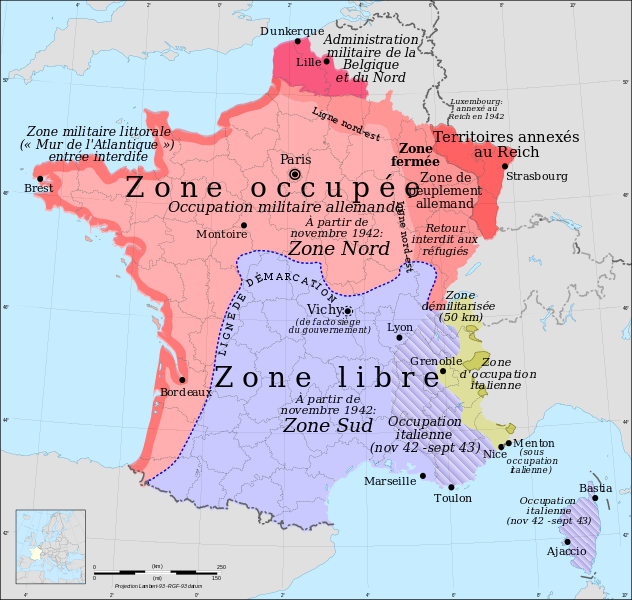Dividing up the country
As shown on the map opposite, France was not split into two, but rather into seven zones:

The occupied zone, covering the north and west of France, fell under German military command. The Vichy regime retained sovereignty over these areas, but the Germany military command based in Paris wielded sweeping powers in their respect and the French administrative authorities were urged to collaborate closely with the occupying forces.
The so-called “free” zone, to the south, which remained under the authority of the Vichy regime.
One zone annexed to Germany (which was subsequently governed by Germany and the Vichy regime had no claim over it).
One reserved zone, intended to accommodate German settlers to ‘germanize’ these areas. Most French refugees were prohibited from returning there. This zone was further divided into:
- one part subject to the occupation regime of the occupied zone, which was under the Paris-based German military command;
- one part attached to the German military government in Brussels.
One zone occupied by Italy, since the Italians were intent on annexing some of these areas.
One forbidden zone, along the Atlantic Coast, which could only be accessed by people with proof of residence there or a valid reason for returning (death of a loved one, wedding, etc.).
The demarcation line: a border across the country
Crossing the line
The 1,200 km-long demarcation line literally cut the country in two. Barriers with guarded checkpoints were erected along the main thoroughfares to prevent people from crossing it, but in the countryside, its existence was indicated simply by red and yellow posts installed at regular intervals. Officers patrolled it repeatedly however, arresting anyone suspected of planning to cross it illegally.
The only legal way to get across it was to show an Ausweis (a “pass”), a document handed out sporadically by the occupying authorities that was by no means easy to obtain. That said, some people – especially on account of their profession – were given a permanent pass.
Restricted correspondence
Communication across the line was also restricted. The occupying forces particularly endeavored to introduce postcards known as “interzone cards”, which were already filled out and only allowed the sender to select which indications applied in his or her situation, for example “am well”, “am still alive”, etc. Over time, this scheme was relaxed to an extent, but correspondence still remained tightly controlled.
A scene of illegal activity
Right from the very first weeks, many people tried to find other, unauthorized ways to cross the line. Whether escaped prisoners of war, Jews fleeing persecution, people wanting to reach free France or relatives living in the free zone, this border was the scene of countless attempts to cross over it.
It didn’t take long for people, whether on their own or as part of a network (not least the one run by Abbé Péan), to specialize in this activity. They had all sorts of reasons for doing so. For many, the decision to help fugitives was evidently motivated by a sense of patriotism and desire to stand up to the occupying forces. But others took advantage of the vulnerability of those wishing to cross the line – Jewish families especially – by demanding large sums of money.
The end of the line
On November 8, 1942, the Allies landed in Morocco. In response to this new threat of a landing in the south of France, the Germans invaded the free zone. At the same time, Italy turned the situation to its advantage by extending its occupation zone.
A few months later, in February 1943, the demarcation line was abolished following a period during which checks were eased. A great many restrictions in terms of movements of people and goods remained across the area for all that, right up until the end of the Occupation.
